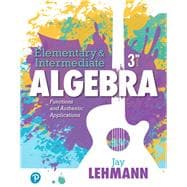For Beginning & Intermediate Algebra combo courses.
Modeling authentic data through curve-fitting gives students new meaning to the math
Seeking the answer to students’ perennial question “But what is this good for?” the Lehmann Algebra Series uses authentic, real-life data sets to find models and derive equations that fit the scenario. The curve-fitting approach teaches the mathematical concepts within the context of data, getting students engaged from the start and building conceptual understanding.
Updates in this revision keep the data sets authentic and current, and provide even more resources for students to practice, review, and explore the concepts.
Also available with MyLab Math
By combining trusted author content with digital tools and a flexible platform, MyLab™ personalizes the learning experience and improves results for each student.
Note: You are purchasing a standalone product; MyLab Math does not come packaged with this content. Students, if interested in purchasing this title with MyLab Math, ask your instructor to confirm the correct package ISBN and Course ID. Instructors, contact your Pearson representative for more information.
If you would like to purchase both the physical text and MyLab Math, search for:
0134776070 / 9780134776071 Elementary & Intermediate Algebra: Functions and Authentic Applications Plus MyLab Math -- Access Card Package, 3/e
Package consists of:
- 0134756975 / 9780134756974 Elementary & Intermediate Algebra: Functions and Authentic Applications
- 013478118X / 9780134781181 MyLab Math with Pearson eText - Standalone Access Card - for Elementary & Intermediate Algebra: Functions and Authentic Applications








